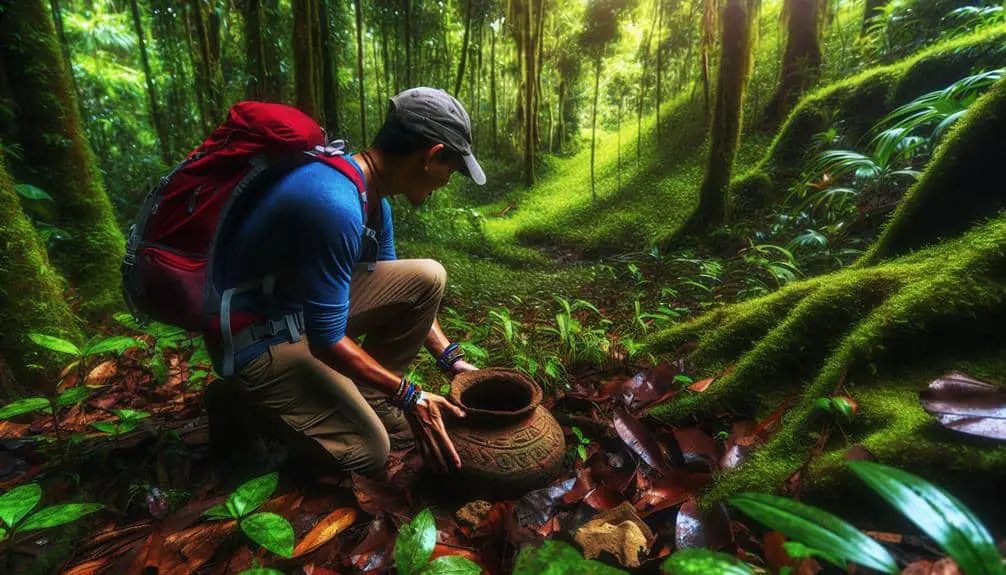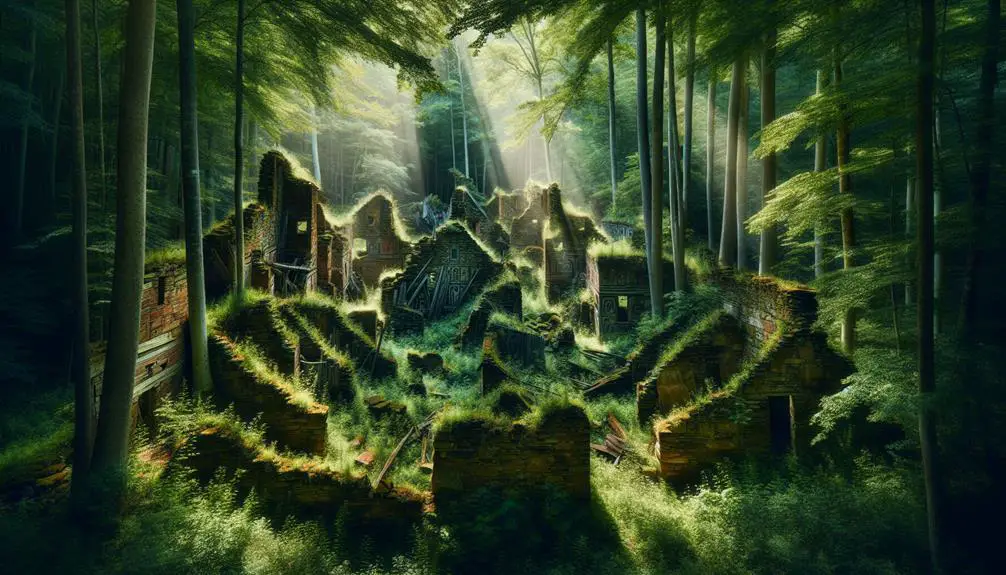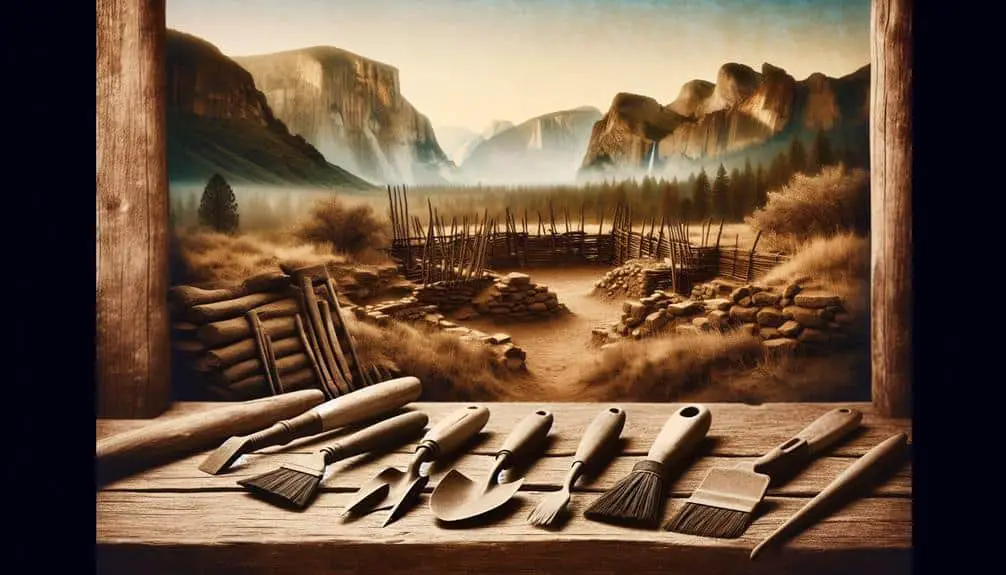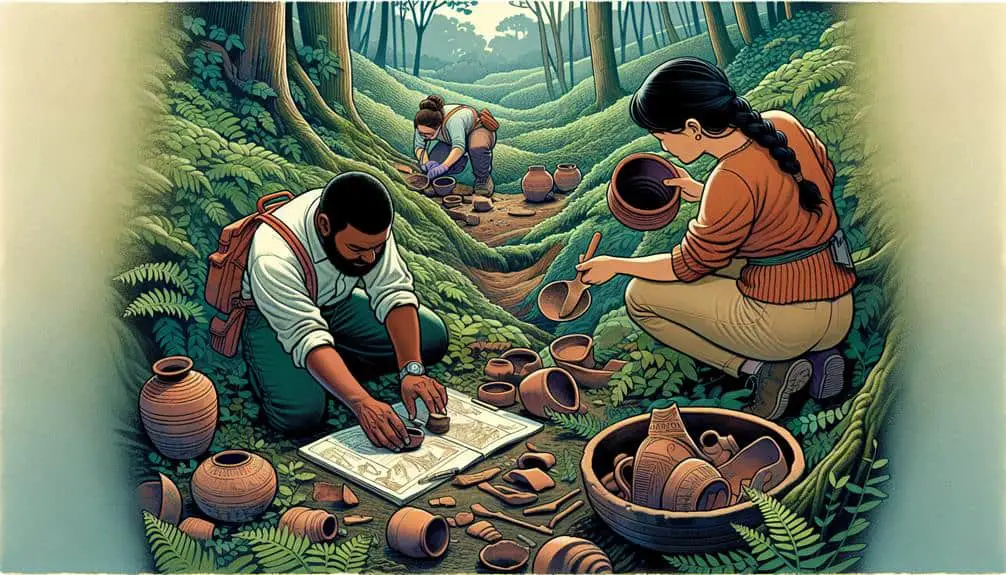When exploring Native American settlement remnants, research local tribes thoroughly to understand their history and culture. Visit archaeological sites to uncover historic ruins and study artifacts to grasp cultural practices. Always respect site boundaries to preserve remnants. Gain insights into indigenous peoples' daily lives through investigation. Understand artifacts to immerse in past civilizations' material remains. Practice proper preservation and documentation techniques for longevity. Show cultural sensitivity by respecting boundaries and joining guided tours for educational insights. Use caution when handling artifacts and share discoveries responsibly. Each tip offers a unique perspective on preserving Native American heritage.
Key Points
- Respect site boundaries to preserve remnants and show cultural sensitivity.
- Join guided tours for educational insights and cultural understanding.
- Share discoveries responsibly to honor Native American heritage.
- Collaborate with local tribes for accurate portrayal of narratives.
- Engage in hands-on learning opportunities to deepen connection with culture.
Research Local Tribes
When exploring Native American settlement remnants, it's vital to thoroughly research the local tribes in the area to gain an in-depth understanding of their history and culture. By delving into tribal customs, traditions, and indigenous land acknowledgments, you can enrich your experience and show respect for the communities that once thrived in these lands.
Understanding tribal customs and traditions is essential when exploring Native American settlement remnants. Each tribe has unique practices that are deeply intertwined with their way of life and beliefs. By researching these customs, you can better appreciate the significance of the remnants you encounter and the stories they hold.
Additionally, acknowledging the indigenous peoples who originally inhabited the land is a sign of respect and recognition. Indigenous land acknowledgments serve as a reminder of the ongoing connection between Native communities and their ancestral territories. It's a way to honor the past and present contributions of these tribes to the land you're exploring.
Visit Archaeological Sites
When visiting archaeological sites related to Native American settlements, you can explore historic ruins that offer valuable insights into the past.
By studying artifacts found at these sites, you can gain a deeper understanding of the daily lives and cultural practices of the indigenous peoples.
Remember to always respect site boundaries to preserve these important remnants for future generations.
Explore Historic Ruins
Investigating historic ruins offers a unique opportunity to explore the past and uncover the secrets of ancient civilizations through firsthand encounters at archaeological sites. Preservation techniques employed in these ruins provide insights into how structures were maintained over time, enhancing site interpretation.
By delving into the cultural context surrounding these ruins, you can gain a deeper understanding of the people who once inhabited these spaces. Architectural features of these ruins showcase the advanced engineering skills of past societies, allowing you to compare and contrast them with modern structures.
Exploring historic ruins not only connects you to history but also encourages you to appreciate the ingenuity and craftsmanship of ancient civilizations. So, go ahead, step into the past, and let these ruins speak to you.
Learn From Artifacts
As you explore historic ruins and witness the preservation techniques employed, visiting archaeological sites provides an invaluable opportunity to learn from artifacts and immerse yourself in the material remains of past civilizations.
Studying artifacts at these sites can offer a deeper understanding of ancient cultures and their way of life. By examining pottery, tools, and other objects, you can gain insights into the daily activities and technologies of these societies. Understanding the techniques used to create these artifacts can shed light on the craftsmanship and skills possessed by the people of that time.
Take the time to carefully observe and interpret these remnants, as they hold valuable clues to unraveling the mysteries of the past.
Respect Site Boundaries
To fully appreciate and preserve the integrity of archaeological sites, it's crucial to always respect designated boundaries when visiting these historical locations. Understanding boundaries not only demonstrates cultural sensitivity but also helps safeguard these sites for future generations. By adhering to set boundaries, you contribute to the preservation of artifacts and structures that hold immense historical and cultural value.
Respecting site boundaries also guarantees that researchers can continue to study these areas without interference, allowing for further insights into the lives of past inhabitants. Comparatively, sites where boundaries aren't honored often suffer damage or loss of valuable information. Embracing the significance of these boundaries showcases a deep appreciation for the Native American history embedded in these settlements.
Consult With Experts
Engage with knowledgeable archaeologists and historians to gain valuable insights into the Native American settlement remnants you're exploring. These experts can provide you with a wealth of information that can deepen your understanding and appreciation of the site.
Here are some reasons why consulting with experts is essential:
- Expert Guidance: Archaeologists and historians can offer expert guidance on how to navigate the site respectfully and responsibly, ensuring that you don't inadvertently damage or disturb any culturally significant artifacts.
- Cultural Heritage: These professionals can educate you on the historical and cultural significance of the settlement remnants, helping you to interpret the site in a more meaningful way.
- Preservation Techniques: Experts can advise you on preservation techniques to help protect the remnants for future generations, ensuring that the site remains intact and undisturbed.
- Restoration Efforts: By consulting with experts, you can learn about ongoing restoration efforts aimed at preserving the site and potentially contribute to these initiatives, furthering the conservation of Native American heritage.
Respect Cultural Significance
Respecting the cultural significance of Native American settlement remnants requires a deep understanding of their historical and symbolic value. These remnants aren't just physical artifacts but carry the weight of generations of traditions and stories. To truly respect these sites, it's essential to comprehend the importance they hold in preserving heritage and understanding traditions that have been passed down through time.
When exploring these remnants, take the time to educate yourself on the cultural practices and beliefs of the Native American tribes that inhabited these areas. By doing so, you can gain a deeper appreciation for the significance of these sites and the role they play in honoring the heritage of indigenous peoples.
Comparatively, respecting the cultural significance of Native American settlement remnants is akin to safeguarding a living museum of history and traditions. Each artifact and structure holds a piece of the past that, when understood and respected, can contribute to a richer tapestry of cultural diversity and preservation.
Document Findings Properly
When recording your discoveries, make sure accurate field notes are taken to capture key details precisely.
Detailed photographic records can provide valuable visual information to complement your written observations.
Comparing and analyzing both types of documentation can offer a thorough understanding of the settlement remnants you encounter.
Proper Field Notes
To properly document your findings in the field, make sure that your notes are detailed, organized, and accurately reflect the context of the Native American settlement remnants you're exploring. When taking detailed notes, pay attention to pottery styles as they can provide vital insights into the culture and time period of the settlement.
Here are some tips for documenting your findings effectively:
- Be Specific: Include precise details like location, depth of artifacts, and any associated materials.
- Use Clear Language: Avoid ambiguous terms and jargon to guarantee your notes are easily understood.
- Record Observations: Note any patterns or anomalies in the pottery styles to aid in analysis.
- Maintain Consistency: Develop a standardized format for your notes to streamline the documentation process.
Detailed Photographic Records
For thorough documentation of your exploration of Native American settlement remnants, meticulous and detailed photographic records are essential to accurately capture the findings. Preservation techniques play an important role in ensuring the longevity of these records.
Utilize conservation methods to safeguard the integrity of the photographs for future reference. When taking photos, remember to employ photography tips such as proper lighting and framing to highlight key features of the remnants.
Additionally, make use of digital tools to enhance and organize your photographic documentation efficiently. By implementing these techniques, you can create a detailed visual record that not only preserves the historical significance of the settlement remnants but also allows for detailed analysis and comparison of the findings.
Learn About Pottery Styles
Explore the intricate world of Native American pottery styles, each revealing unique cultural nuances and artistic expressions. To truly appreciate the richness of Native American pottery, it's essential to study pottery techniques and identify pottery styles. Here are some key points to ponder when delving into the diverse world of Native American pottery:
- Materials: Native American pottery styles vary based on the materials used, such as clay types and pigments. Understanding the materials can provide insights into the cultural and environmental contexts of the pottery.
- Design Patterns: Different tribes and regions have distinct design patterns that are reflected in their pottery styles. By analyzing these patterns, you can discern the symbolic meanings and historical significance embedded in the designs.
- Firing Techniques: The firing techniques employed by Native American potters influence the final appearance and durability of the pottery. Learning about these techniques can enhance your understanding of the craftsmanship involved.
- Influences and Evolution: Native American pottery styles have evolved over time due to influences from neighboring tribes and changing cultural practices. By tracing these influences, you can observe the dynamic nature of Native American pottery traditions.
Explore Trail Markers
As you investigate the exploration of trail markers, consider the intricate network of symbols and messages embedded within these historical artifacts. Trail symbolism plays a significant role in understanding Native American cultures and their navigation techniques. These markers weren't merely directional signs but also carried hidden messages that conveyed important information about the surrounding environment, resources, and potential dangers. By studying these symbols, you can gain insights into how indigenous communities communicated and shared knowledge across vast landscapes.
Exploring trail markers provides a window into the historical context of Native American societies, revealing their sophisticated understanding of the land and their strategic use of natural landmarks for navigation. Comparing different markers from various regions can highlight the diversity of symbols used and the cultural significance attached to specific motifs. By immersing yourself in the study of trail markers, you can unravel the rich tapestry of indigenous knowledge and traditions that have shaped these landscapes for centuries.
Join a Guided Tour
When you join a guided tour, you benefit from expert-led exploration that provides you with in-depth knowledge and understanding of the Native American settlement remnants. These tours offer educational insights that go beyond what you might discover on your own, enriching your experience and appreciation for the historical significance of these sites.
Compared to independent exploration, guided tours can offer a more thorough and detailed look at the remnants, giving you a deeper insight into the culture and history of the Native American communities that once thrived there.
Expert-Led Exploration
Starting a guided tour led by experts provides invaluable insights into the rich history and significance of Native American settlement remnants. Here are four reasons why joining a guided tour can enhance your exploration experience:
- Expert Guidance: Benefit from the knowledge and expertise of seasoned guides who can offer in-depth explanations and answer your questions.
- Immersive Experience: Engage all your senses and explore the indigenous history through interactive activities and storytelling.
- Hands-On Learning: Get the opportunity to touch artifacts, participate in traditional crafts, and truly connect with the culture.
- Safety and Efficiency: Enjoy a well-organized tour that guarantees you visit important sites, learn efficiently, and stay safe throughout the exploration.
Educational Insights
Join a guided tour to explore the intricacies of educational insights waiting to be uncovered within Native American settlement remnants. These tours offer a unique opportunity to plunge into the depths of cultural preservation and historical interpretation.
By participating in guided tours led by knowledgeable experts, you can gain a deeper understanding of the ways in which Native American communities lived, thrived, and interacted with their environment. These experiences provide a comparative lens through which you can analyze the similarities and differences between modern society and ancient civilizations.
Engaging in guided tours not only enriches your knowledge but also fosters a sense of connection to the past, allowing you to appreciate the significance of preserving Native American heritage for future generations.
Use Caution in Handling Artifacts
Handle artifacts with care to preserve their historical significance and integrity. When exploring Native American settlement remnants, it's important to approach artifact handling with caution and respect. Here are some tips to make sure you handle artifacts ethically and responsibly:
- Avoid touching artifacts with bare hands: Oils and dirt from your skin can damage the artifacts over time. Wear gloves to protect them.
- Do not remove artifacts from their original location: Removing artifacts can disrupt the historical context and significance. Document their placement instead.
- Use proper tools for handling: Utilize brushes, trowels, and other tools designed for artifact excavation to prevent accidental damage.
- Keep detailed records: Record the location, condition, and any observations about the artifact to maintain a thorough history of your findings.
To guarantee the preservation and respect of Native American heritage, it's essential to share your discoveries responsibly. Approach respectfully when encountering Native American settlement remnants. Consider the significance these sites hold for indigenous communities and the importance of preserving their cultural history. Share findings responsibly by refraining from disclosing exact locations of sensitive sites. This helps protect these areas from looting and vandalism, safeguarding the integrity of the artifacts and the historical context they provide.
Comparatively, sharing discoveries responsibly also involves acknowledging the perspectives and voices of Native American communities. Engage with local tribes and seek their input on how best to share information about the sites you encounter. Collaborate with indigenous groups to ensure that the narratives surrounding these settlements are accurately portrayed and respectfully shared with the broader public.
Frequently Asked Questions
How Can I Properly Determine the Cultural Significance of a Native American Settlement Remnant?
To understand the cultural significance of a Native American settlement remnant, immerse yourself in its history, artifacts, and stories. Respect cultural preservation by consulting experts, researching local history, and acknowledging the community's perspectives. This approach fosters meaningful understanding.
Are There Any Specific Protocols I Should Follow When Documenting My Findings at a Site?
When documenting findings at a site, guarantee respectful engagement and ethical documentation. Show reverence for the past by carefully recording and preserving details. Your commitment to accuracy and sensitivity will honor the heritage.
What Are Some Common Misconceptions About Native American Pottery Styles That I Should Be Aware Of?
When exploring Native American pottery styles, be cautious of misconceptions about authenticity. Different tribes have unique techniques and designs. Remember, not all pottery pieces are trail markers. Research and consult with experts to avoid misunderstandings.
How Can I Differentiate Between Authentic Trail Markers and Modern Replicas?
Spotting authentic trail markers involves scrutinizing materials, craftsmanship, and historical accuracy. Look for subtle aging signs like weathering or patina. Avoid damaging relics; respect their cultural significance. Verify authenticity to preserve heritage ethically.
What Are Some Ways to Ensure That I Am Sharing My Discoveries Responsibly With the Public and Respecting the Cultural Significance of the Site?
To guarantee responsible sharing and cultural respect of your discoveries, consider the historical context and significance of the site. Engage with local communities, seek permission, and educate yourself on proper protocols. Share information thoughtfully and respectfully.



